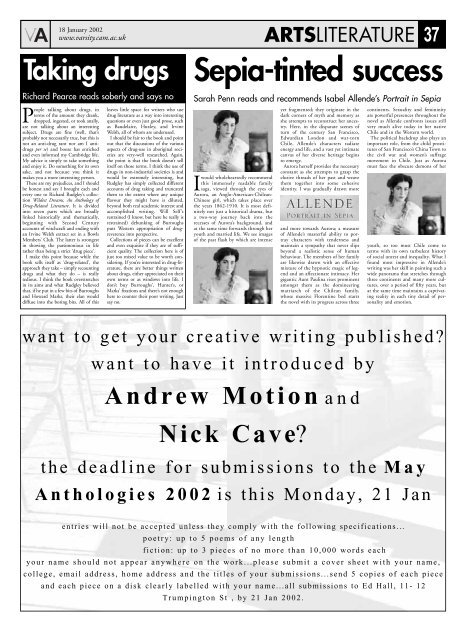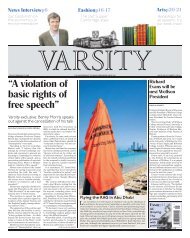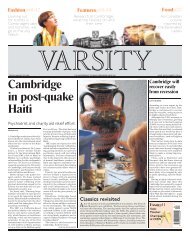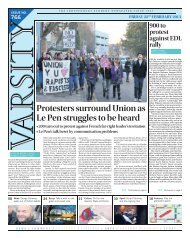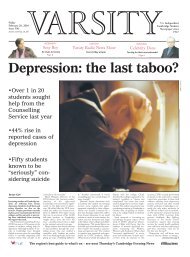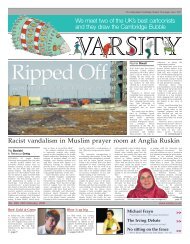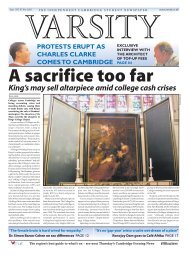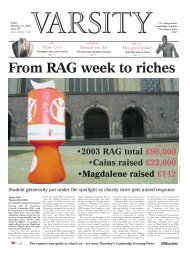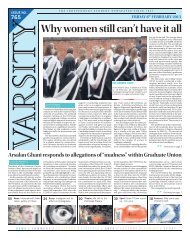36 ARTSLITERATURE18 January 2002www.varsity.cam.ac.uk AFusion, forks and flavoursMarcus Omond investigates cookbooks, and cooks the Literature Editor three dinners tooSimultaneous to the growth of theever more tenuous “fusion” cookeryadvocated by cookbook writers(Gordon Ramsey’s Thai rice pudding withcoconut and lemongrass, for example), isa fusion of genre: the previously separatecookbooks and self-help books are meldingtogether. Most new cookbooks comewith a wholly integrated “philosophy”.Nadine Abensur, for example, explainsher relationship with chicory thus:“Maybe it’s my dosha (Ayurvedic mindbodyclassification), but I often seem tocrave a slight bitterness; even withoutexactly liking it, it seems to satisfy somedeep need in me”. If Abensur’s recipesweren’t invariably delicious, her new agetone would be enough to put me off hersuperb Cranks Bible.This limp, unintellectual engagementwith other cultures characterises the worsecookbooks currently published. Wholecivilisations are reduced to glib phrases;their ways of life are sanitised so as topaint “taste the difference” picture postcards.Hence, Ursula Ferrigno’s BringingItaly Home has prose with a remarkableabsence of thought: its introduction gushesforth on “the importance of eating tothe Italians”. “The streets are silent and, ifyou listen closely, the sound of knives andforks can be heard. There will also belaughing and arguing, for eating is a passionateaffair.” The book is divided intoseasons, each chapter begins with a limpfew lines of verse: Keats for autumn,Swinburne for spring, some pathetic linesthat Marvell didn’t write but which arelibellously attributed to him for summer.This limpness wouldn’t matter if it didn’tcarry over to the food too: Ferrigno’s choseningredients are those of the intellectuallylazy vegetarian; no meat, but fish isOK. With the importance of pork productsto Italian cooking, this seems almostas ludicrous as her neglecting to mentionthe importance of Catholicism to allItalian domestic life, including cooking.The food is invariably plain, tasting asbland as the coffee sold in Café Nero,where this ghastly book is available.Avoid.Anna del Conte’s Gastronomy of Italy ismore concerned with explaining howItalian food works than providing sepiaimages of authentic peasant life; as aresult, her book is better. Her book is rigorouslyencyclopaedic, with extensive sectionson ingredients and regional variations;no bland, uniform Italy for her. Herprose too avoids gush; although she is passionateabout food and hopes “this passionwill glow through my words”, by layingoff the superlatives, over-simplificationsand stylistic damp squibs she lets thefood shine on its own. The recipes shegives invariably taste delicious; moreover,her instructions are unhindered by theirritatingly chatty tone of her compatriot’stome. This book is admirably untrendyand delicious to cook from.Del Conte’s book is like Sam and SamClark’s Moro: The Cookbook in insistingon an uncompromising authenticity. TheClark’s use of “sumac”, “wheat berries”and “mojama” symptomises their incrediblegeographical focus: Mediterraneanpinenuts “are highly prized and superiorto the Asian variety”; “The area around LaMancha in central Spain produces someof the best-quality saffron in the world”.In tandem to this insistence on absolutecultural authenticity, the writers help uspedestrian, un-cosmopolitan Brits withuseful translations like “we quenched ourthirst with ice-cold ‘cervezas’ (beers)”. Thefood, like del Conte’s, is wonderful, butrequires inordinate prep time: growingsourdough mixes and live yoghurt is finefor hippies or Chelsea housewives, but notfor students with tiny shared kitchens.The combinations of flavours, though, aredoable; any prospective romantic interestis going to be vastly impressed with cauliflowerwith saffron, pinenuts and raisinsor duck breast with okra and pomegranatemolasses.Restaurateurs’ cookbooks in general sufferin that they assume teams of skilledsubordinates are at hand; hence they tendto come up with recipes which are deliciousbut incredibly difficult. GordonRamsey’s Just Desserts suffers here: whilehe may think that choux pastry “is one ofthe easiest pastries to make”, lesser mortalsmay disagree. But most of his food isachievable, especially with his gentle yetfirm instruction; and the thrill of makinga delicious orange pannacotta or pumpkincheesecake successfully almost makes upfor the five hours you’ve spent in thekitchen. Tetsuya Wakeda’s Tetsuya, however,is more difficult. Finding the ingredientsalone is a nightmare (black sesameseeds and live sea trout anywhere inCambridge?); but turning them into thecolourful tower blocks he favours is nighon impossible. This book looks gorgeous;but as a cookbook it is rather useless.Occupying the other extreme of theculinary spectrum is The River CottageCookbook. Hugh Fearnley-Whittingstall’sself-sufficiency creates photos a worldfrom Tetsuya’s; whereas his sea food isarranged with twigs to look pretty, HughFearnley-Whittingstall’s cuttlefish beinggutted in the bath looks more like one ofFred West’s family snaps. This book is notfor the squeamish: there are plenty of picturesof lambs being taken to slaughter,game being hung and squirrels beingskinned. But the approach is refreshinglyhonest: meat is dead animal, and better toraise or hunt your dinner yourself, thusensuring animals’ welfare, than buy thesupermarkets’ intensively raised produce.The River Cottage Cookbook takes theself-help crossover idea to its furthestextent: it suggests a new way of living(although it admittedly also offers lessextreme self-help than slitting a pig’sthroat and collecting the blood for breakfast).The other book published last yearthat really wants to rearrange your life isJohn Pawson and Annie Bell’s Living andEating. John Pawson, reputedly a fineminimalist architect, is fascist in his insistenceon specific bijouterie: “it is useful tohave a couple of small dishes for tasks suchas roasting nuts. Those produced by Staubare ideal”. But his insistence on clutterbelies his minimalist pretensions; ratherthan having nothing, he stuffs his cupboardswith “the most restrained off-whitechina” and “Georgian silver candlesticks[which] possess a timeless elegance”. Werethe recipes as ghastly as Pawson’s limp aesthetic,this book would be on its way toOxfam; but Annie Bell is consistentlystunning. Although her tone can grate(“Knowing how to fix a mean BloodyMary is an essential social skill”), herrecipes are easy to cook and delicious:beetroot and apple soup, chicken baked insalt with lapsang souchong, chocolatemousse cake. Along with the del Conteand Abensur, she provides classy contentin a publishing sphere increasingly dominatedby incompetent celebrity cooks.LIT SHORTSHeffersGet your black polo-neck out. Theanthology Oxford Poets 2001 celebrateswith readings tonight byMaureen Duffy, Peter Scupham,Peter Howard, Jane Draycott,Carmen Bugan and Robert Saxton.Friday 18th January. 6-7.30pm. Noticket required.Ed McBain, the celebrated crimefiction writer, reads from and signscopies of his new book, Money,Money, Money, which deals withcontraband drug smuggling.Thursday 24th January. 6-7.30pm.Ticket required. Free.Wanna Write?Barbarellajoint.com is a newonline, monthly magazine focusingon social change and cutting-edgearts, style and music reporting.The name is taken from the cultmovie Barbarella, starring JaneFonda, and the first issue is due thisSpring, focusing on ‘peace’. They’relooking for writers of all kinds, whowant to do both Cambridge andnon-Cambridge-focused reviews,interviews, and creativing writing.Contact Ruth at Ruthiecolbird@yahoo.co.uk or 07866801915 formore information.Literatureon the bedside tableSarah Savitt does nowork at all and thusinterviews the newLiterature Editor,Sameer Rahim, in theoffice.Currently Reading: I’ve just pickedup Giles Foden’s The Last King ofScotland, which is about Idi Amin’sdictatorial regime in Uganda, toldthrough the eyes of his personal doctor.I’m enjoying it even though hisprose style is a bit too journalistic. I’malso tackling Frantz Fanon’s BlackSkin White Masks which is a strangemixture of poetic prose, radical philosophy,and political agit prop. I’vealso just started reading Jane Eyre forthe first time.Must Re-Read: I am always meaningto re-read Martin Amis’ Money, whichwas one of the most enjoyable fictionalexperiences of my life. His lethalprose makes this a good book to readwhen you’re feeling angry with theworld. I should get around to readingMidnight’s Children again if only forRushdie’s wonderful exuberant style. Ihave a nagging feeling that Ulysses isalso one of those novels that certainlywarrants re-reading.Childhood-Reading: My childhoodreading covered pretty much theentire ouevre of Enid Blyton (FamousFive, Five Find Outers, Secret Seven,etc.) and an author who nobodyseems to have ever heard of – WillardPrice. He wrote about the adventuresof two rugged American boys who goto exotic locations and collect animalsfor their father’s zoo. They’re packedfull of interesting information aboutanimals, none of which I can actuallyremember.Meaning to Read: There are so manybooks that I want to read that I amcontinually adding to my list, butapart from the usual (Proust, Marx,etc.) I would love to finish GittaSereny’s Albert Speer: His Battle withTruth. I read the first fifty pages overthe summer but had to give it up. It isbased on interviews with Speer, whowas Hitler’s architect, but got off atNuremberg. It is an examination ofhis post-war guilt over his knowledgeof the Holocaust.
A18 January 2002www.varsity.cam.ac.ukARTSLITERATURE37Taking drugsSepia-tinted successRichard Pearce reads soberly and says noPeople talking about drugs, interms of the amount they drank,dropped, ingested, or took anally,are not talking about an interestingsubject. Drugs are fine (well, that’sprobably not necessarily true, but this isnot an anti-drug rant nor am I antidrugsper se) and booze has enrichedand even informed my Cambridge life.My advice is simply to take somethingand enjoy it. Do something for its ownsake, and not because you think itmakes you a more interesting person.These are my prejudices, and I shouldbe honest and say I brought each andevery one to Richard Rudgley’s collectionWildest Dreams, An Anthology ofDrug-Related Literature. It is dividedinto seven parts which are broadlylinked historically and thematically,beginning with Second Centuryaccounts of witchcraft and ending withan Irvine Welsh extract set in a BowlsMembers’ Club. The latter is strongestin showing the parsimonious in liferather than being a strict ‘drug piece’.I make this point because while thebook sells itself as ‘drug-related’, theapproach they take – simply recountingdrugs and what they do – is reallytedious. I think the book overstretchesin its aims and what Rudgley believedthat, if he put in a few bits of Burroughsand Howard Marks, their elan woulddiffuse into the boring bits. All of thisleaves little space for writers who usedrug literature as a way into interestingquestions or even just good prose, suchas Baudelaire, Huxley, and IrvineWelsh, all of whom are underused.I should be fair to the book and pointout that the discussions of the variousaspects of drug-use in aboriginal societiesare very-well researched. Again,the point is that the book doesn’t sellitself on those terms. I think the use ofdrugs in non-industrial societies is andwould be extremely interesting, butRudgley has simply collected differentaccounts of drug taking and truncatedthem to the extent where any uniqueflavour they might have is diluted,beyond both real academic interest andaccomplished writing. Will Self’srestrained (I know, but here he really isrestrained) debunking of Burroughsputs Western appropriation of drugreverenceinto perspective.Collections of pieces can be excellentand even exquisite if they are of sufficientquality. The collection here is ofjust too mixed value to be worth considering.If you’re interested in drug-literature,there are better things writtenabout drugs, either appreciated on theirown terms or as windows into life. Idon’t buy Burroughs’, Hunter’s, orMarks’ fixations and there’s not enoughhere to counter their poor writing. Justsay no.Sarah Penn reads and recommends Isabel Allende’s Portrait in SepiaIwould wholeheartedly recommendthis immensely readable familysaga, viewed through the eyes ofAurora, an Anglo-American-Chilean-Chinese girl, which takes place overthe years 1862-1910. It is most definitelynot just a historical drama, buta two-way journey back into therecesses of Aurora’s background, andat the same time forwards through heryouth and married life. We see imagesof the past flash by which are intenseyet fragmented; they originate in thedark corners of myth and memory asshe attempts to reconstruct her ancestry.Here, in the disparate scenes ofturn of the century San Francisco,Edwardian London and war-tornChile, Allende’s characters radiateenergy and life, and a vast yet intimatecanvas of her diverse heritage beginsto emerge.Aurora herself provides the necessaryconstant as she attempts to grasp theelusive threads of her past and weavethem together into some cohesiveidentity. I was gradually drawn moreand more towards Aurora; a measureof Allende’s masterful ability to portraycharacters with tenderness andmaintain a sympathy that never slipsbeyond a realistic sense of humanbehaviour. The members of her familyare likewise drawn with an effectivemixture of the hypnotic magic of legendand an affectionate intimacy. Hergigantic Aunt Paulina rises prominentamongst them as the domineeringmatriarch of the Chilean family,whose massive Florentine bed startsthe novel with its progress across threecontinents. Sexuality and femininityare powerful presences throughout thenovel as Allende confronts issues stillvery much alive today in her nativeChile and in the Western world.The political backdrop also plays animportant role, from the child prostitutesof San Francisco’s China Town tothe civil war and women’s suffragemovement in Chile. Just as Auroramust face the obscure demons of heryouth, so too must Chile come toterms with its own turbulent historyof social unrest and inequality. What Ifound most impressive in Allende’swriting was her skill in painting such awide panorama that stretches throughthree continents and many more cultures,over a period of fifty years, butat the same time maintains a captivatingreality in each tiny detail of personalityand emotion.want to get your creative writing published?want to have it introduced byAndrew Motion andNick Cave?the deadline for submissions to the MayAnthologies 2002 is this Monday, 21 Janentries will not be accepted unless they comply with the following specifications...poetry: up to 5 poems of any lengthfiction: up to 3 pieces of no more than 10,000 words eachyour name should not appear anywhere on the work...please submit a cover sheet with your name,college, email address, home address and the titles of your submissions...send 5 copies of each pieceand each piece on a disk clearly labelled with your name...all submissions to Ed Hall, 11- 12Trumpington St , by 21 Jan 2002.


